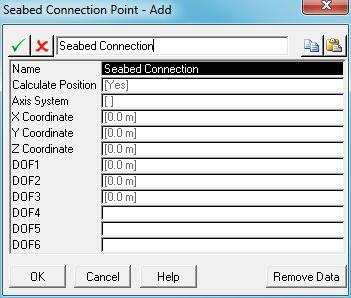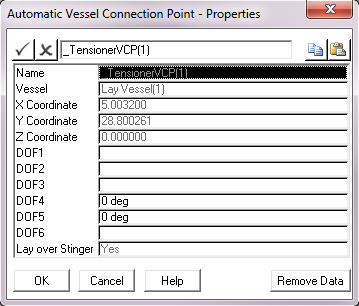In order to define the location of many components in the model (e.g. pipelines, cables etc.), it is necessary to define connection points. There are three types of connection point – fixed, seabed and vessel. The fixed and seabed types are typically used to model a constraint on the seabed, while a vessel connection is used to connect a component to a vessel. Adding new connection points is a similar to adding vessels.
Add a seabed connection point to represent the end of your pipeline on the seabed. Click on the Seabed Connection Points folder in the sub-component list, and press the Add button. Name this connection point Seabed Connection and set Calculate Position to Yes so as to allow the Model component to automatically predict a suitable X Coordinate, Y Coordinate and Z Coordinate for the connection point.
The Axis System drop-down list allows you to apply constraints in an arbitrary local axis system. In this case, the global axis system is appropriate and you may ignore this input. By default DOF1, DOF2 and DOF3 are set to zero for a seabed connection point while the other remaining entries are blank. This default setup represents a pinned connection and it is sufficient in the case of this example. Note that a pinned connection means that the pipeline end is prevented from moving vertically or horizontally but rotation is not constrained. When you have entered the data outlined in Example 3, the Add Seabed Connection Point dialog appears as shown in the figure below, and you may press OK to confirm and close the dialog.

Seabed Connection
Back to Creating the Model Overview
In PipeLay, connection point locations define the location of the centre-line of items attached to them. In contrast, tensioner locations generally correspond to the bottom outer surface of items supported by them. These two facts can make it cumbersome to manually connect a line to a tensioner using a vessel connection point. The figure below further illustrates the relative locations of tensioners and vessel connection points.

Location of the Vessel Connection Point
In order to simplify and expedite the model setup process the Model component automatically creates suitable vessel connection points at all tensioner locations in a model. The operation of these default vessel connection points is described in detail in the Model component article.
In the case of this example there is only one tensioner present on the vessel and so only one default vessel connection point appears in the Vessel Connection Points folder. This connection point is automatically named _TensionerVCP(1) and is directly associated with Lay Vessel(1). The X Coordinate, Y Coordinate and Z Coordinate for the connection are set by the model component and are dependent on the tensioner location as well as any connected component. Given that default vessel connection points coincide with tensioners it is possible to leave the DOF1-DOF3 entries blank and set DOF4-DOF5 to zero for _TensionerVCP(1) as outlined in Example 3 and shown in the figure below.

_TensionerVCP(1)
Back to Creating the Model Overview
The next step in creating a model is to add the pipeline created in 'Assembling Pipeline Stack-Up'. The process of adding the pipeline is described in the 'Adding a Line' article.